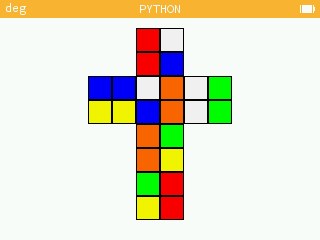Amélioration du programme Rubik avec visualisation éclatée du cube 2x2x2
Vous pouvez tester par exemple avec >> ordre("FR")

from kandinsky import * U=[(8,9,11,10),(2,12,17,7),(3,14,16,5)] R=[(12,13,15,14),(23,19,11,3),(21,17,9,1)] L=[(4,5,7,6),(0,8,16,20),(2,10,18,22)] F=[(16,17,19,18),(6,10,14,21),(7,11,15,20)] D=[(20,21,23,22),(18,15,1,4),(19,13,0,6)] B=[(3,2,0,1),(13,9,5,22),(12,8,4,23)] CUBES = 4 COUL="RBWVOJ" # Couleurs et positions des faces RVB={"R":(255,0,0), "B":(0,0,255), "W":(255,255,255), "V":(0,255,0),"O":(255,190,0),"J":(255,255,0)} COINS=[[136,10],[88,58],[136,58],[184,58],[136,106], [136,154]] def inv(l): return [tuple(reversed(t)) for t in reversed(l)] # Affichage d une facette en couleur def aff(v, c): xy=COINS[v//4] for i in range(24*24): coul = RVB[c] if 0<i%24<23 and 0<i//24<23 else (0,)*3 set_pixel(xy[0]+24*(v%2)+i%24,xy[1]+24*((v%4)//2)+i//24,coul) def permu(c, pos): suiv = list(pos) mvt = inv(eval(c.upper())) if c==c.lower() else eval(c) for t in mvt: u = (t[-1],)+t for i,v in enumerate(t): suiv[v] = pos[u[i]] aff(v, suiv[v]) return suiv def fin(pos): c, nb = pos[0], 1 for v in pos: if v != c: c = v nb += 1 return nb == len(COUL) def ordre(m): cube = "" for c in COUL: cube += c*CUBES pos=list(cube) for i,v in enumerate(pos): aff(i,v) nb = 1 while True: p = input() for k,c in enumerate(m): pos = permu(c,pos) if fin(pos): draw_string(str(nb),10,10) return True nb += 1